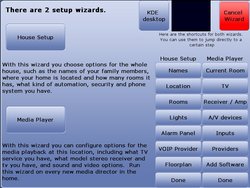QuickStart Guide
This Quick Start Guide assumes you have already completed the installation.
Basics
If you haven't already installed LinuxMCE, start with the Detailed step-by-step instructions for installing LinuxMCE. Also, it's strongly recommended you read the short Architecture Intro to understand in general terms how the pieces of LinuxMCE work together, and also the Usage Intro which is just a quick overview on how to use LinuxMCE. For a more detailed look at LinuxMCE you can visit the User Manual page which is loaded with links to various How-To's and better more complete documentation.
This Quick Start guide explains how to use the AV Wizard to set your screen resolution and audio settings, and the Setup Wizard to tell LinuxMCE about your family members, the rooms in your home, and some of the basic devices you want to control. Both the AV Wizard and Setup Wizard together take only about 15 minutes to complete.
If, during the installation of LinuxMCE you did not specify that LinuxMCE should be started by default, you can start it now from the Kubuntu system menu > Application > Sound & Video > Start 'LinuxMCE Center'
First Time Running LinuxMCE
Verifying Installaion
The first time you do a start-up it will take somewhere between 5 and 10 minutes so it can verify your installation. After that, startup takes about 30-60 seconds, during which time some software/services such as mysql server are started; no other interaction is needed.
A/V Wizard
The first time LinuxMCE is run, the AVWizard starts automatically. The video and audio settings that LinuxMCE can now be chosen. (Note: these settings have no effect on the Kubuntu desktop -- they are for LinuxMCE only.)
By default LinuxMCE initially uses VGA at a low resolution for the A/V Wizard. If you are connecting to a display that uses anything other than VGA, see the directions below. If for any reason the A/V Wizard fails to start, or if you only see a black screen, see the troubleshooting directions below, as well.
Detailed instructions for the A/V Wizard and Troubleshooting A/V Wizard are here.
Explaining User Interface Options
The AVWizard will guide you through the audio/video settings for your hardware. You will be presented with 3 choices for the user interface: UI1, UI2 with masking, and UI2 with alpha blending. UI2 with alpha blending is generally considered the best, but it requires that your video card support X's composite extensions. At this time, only nVidia 6xxx or greater can do this. This is the recommended platform for LinuxMCE. UI2 with masking has the same 3D OpenGL effects, but is less demanding on the hardware and will run on most video cards that have decent OpenGL and XDamage support. UI1 is the simplest because it has no 3d effects and never puts any graphics on top of the video. UI1 should run on nearly all Linux-compatible video cards. See Screenshots to see the differences between the 3 UI options.
Explaining TV Overscan
IMPORTANT: In Step 4 ofn the AVWizard, if your TV doesn't overscan (meaning it doesn't crop off the edges), you should see all 4 yellow arrows completely. If your TV does overscan, be sure to hit the - key to reduce the image until all 4 arrows are fully visible. Use the arrow keys to shift the image. The goal is that all 4 arrows should be centered and as close to the edges of your screen as possible, without being cropped off. This is where LinuxMCE displays the user interface. (Your movies and media themselves are always full-screen and are not effected by this.)
AVWizard Steps
These are the steps in AVWizard:
 |
 |
 |
 |
 |
 |
 |
 |
 |
 |
 |
The final step asks for a confirmation of these steps. If you press 'I agree' the installation will continue and the Media Center will be started.
House Setup Wizard
There is an interactive setup wizard built-into the GUI. It doesn't allow a lot of customization, but it's a very fast and easy way to get up and running in about 5 minutes, using all the default features of LinuxMCE.
Adding Rooms and Users
IMPORTANT: At this time you don't have any rooms or users (i.e. family members) added to LinuxMCE. Because LinuxMCE is a whole house solution and manages all your family members' content, you must, at a minimum, provide a list of the Rooms and Users in your home, specifying which Room this system is in. This must be done before you can use LinuxMCE.
House Setup Wizard Steps
For a more detailed description Click Here
Here are some screen shots from the setup wizard:
 |
 |
 |
 |
 |
 |
 |
 |
After the Video Wizard is ended and the house is entirely setup, press 'start using the system'. This action will regenerate the interface with the new changes you've made.
Starting House Setup Wizard Later
To start the setup wizard, choose Misc --> Advanced Options from the GUI and then 'Setup Wizard'.
Other Setup Options
If you want to dive right in, you can skip the other setup steps for now, but you cannot use LinuxMCE until you specify the Rooms and Users.
Using LinuxMCE Admin Website
To do this, login to the LinuxMCE Admin Website panel from your LinuxMCE system (or any other PC in the house) as explained on the LinuxMCE startup screen. A walk-through of the LinuxMCE Admin Website is available, but if you want to just get going ASAP, choose Wizard --> Basic Info --> Rooms. Also choose Wizard --> Basic Info --> Users to specify the Rooms and Users, and Wizard --> Devices --> Media Directors to specify which room this system is in.
Commercial DVDs
IMPORTANT: If you intend to watch commercial DVDs in LinuxMCE, pay attention to the Restricted Software Installation Guide mentioned in those installation instructions.